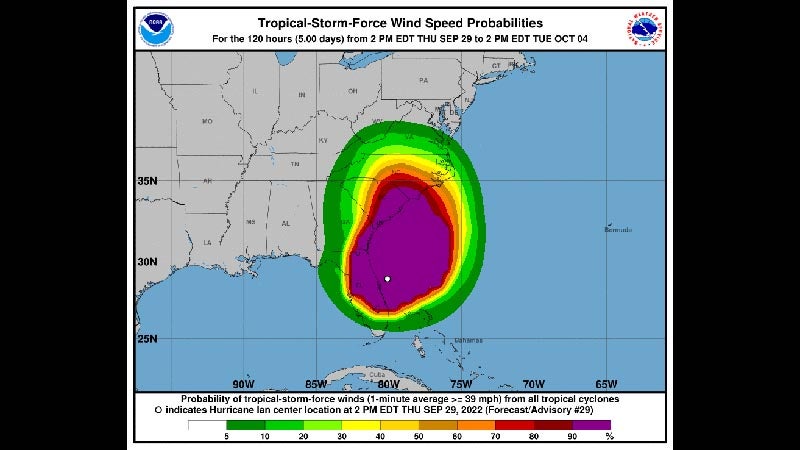Coastal flood advisory, state of emergency issue in advance of Ian’s arrival
Published 6:16 pm Thursday, September 29, 2022

- Hurricane Ian
|
Getting your Trinity Audio player ready...
|
As hurricane Ian strengthens over the Atlantic and moves toward another landfall Friday in South Carolina, officials are preparing for its effects in Virginia.
The National Weather Service is forecasting that Suffolk and the Tidewater region could see rainfall in excess of 7 inches as the hurricane moves up the east coast.
Gov. Glenn Youngkin declared a state of emergency for the regions of the state it is expected to hit and the National Weather Service has issued a coastal flood watch for Suffolk and the region.
The Wakefield NWS office said the watch is in effect from Friday afternoon through Friday evening due to an expected two-feet of inundation above ground level that is possible in low-lying areas near shorelines and tidal waterways.
The weather service said this may lead to numerous road closures. Homes, businesses and some critical infrastructure in low-lying areas also could be inundated. NWS said some shoreline erosion is also possible with the storm.
Additional flooding is possible on Saturday with the next high tide.
The Suffolk forecast predicts rain beginning here after 5 a.m. Friday and continuing through Sunday night. In all, the weather service expects Ian could dump as much as 7 inches of rain in the city, with 2-3 inches possible during the daytime hours Friday, another 2-3 inches overnight Friday into Saturday morning and smaller amounts as bands of rain from Ian spread out along the coast.
In preparation for Ian’s arrival, Gov. Youngkin said the state of emergency allows the Commonwealth to mobilize resources and equipment needed for response and recovery efforts.
“Hurricane Ian is a large, powerful storm, and current predictions indicate that it may impact parts of Virginia later this week into early next week,” said Governor Glenn Youngkin. “We want to ensure that our communities have the resources needed to respond to and recover from any potential effects from the storm. While we recognize that the storm track is still uncertain, I nevertheless encourage all Virginians and visitors to make a plan, have supplies on hand, and follow official sources for the latest forecast information and guidance.”
Virginians should be prepared for the potential of severe rainfall, flooding, wind damage, tornadoes, and other storm-related impacts, the governor said in a news release issued Thursday.
State officials offered the following recommendations to prepare for Ian:
- Make a plan. Plan in advance a route to a safe place, how you will stay in contact with family and friends, and what you will do in different situations. Additional planning resources are available at https://www.vaemergency.gov/prepare/make-a-plan/.
- Prepare an emergency kit. For a list of recommended emergency supplies to sustain your household before, during, and after the storm visit: VAemergency.gov/emergency-kit.
- Stay informed. Virginians should follow the Virginia Department of Emergency Management on Twitter and Facebook for preparedness updates and their local National Weather Service office for the latest weather forecast, advisories, watches or warnings. Download the FEMA app on any smartphone to receive mobile alerts from the National Weather Service. Power outages are always a concern during weather events — make sure to have a battery-operated radio available to receive life-saving alerts.
Virginia State Police also are reminding Virginians in the path of the storm to drive safely. VSP offered the following recommendations for motorists in a Thursday news release:
- Slow speed for road conditions.
- Add extra time to reach travel destinations.
- Increase driving distances between vehicles for increased stopping distance, do not tailgate.
- Use headlights to increase visibility.
- Put down the cell phone and avoid distractions.
- Buckle up and arrive alive.
- Move over for all stopped emergency vehicles — police, fire, emergency medical services, Virginia Department of Transportation and tow trucks.
- Check vehicles to ensure they are in good working condition.
- Turn around, don’t drown — never drive through standing water. What looks like a puddle can be deep and/or swift-moving water.
VSP also said motorists are also asked to not abandon their vehicles in the roadway as this causes even more delays and prevents VDOT trucks and other emergency vehicles from being able to move through the area.
In case of emergencies, state police said to call 911 or dial #77 on any cellular phone.






